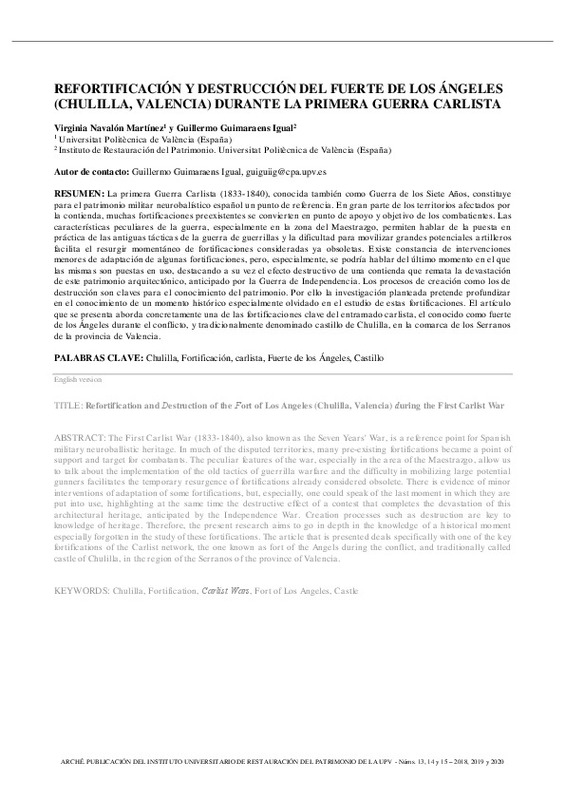|
Resumen:
|
[ES] La primera Guerra Carlista (1833-1840), conocida también como Guerra de los Siete Años, constituye para el patrimonio militar neurobalístico español un punto de referencia. En gran parte de los territorios afectados ...[+]
[ES] La primera Guerra Carlista (1833-1840), conocida también como Guerra de los Siete Años, constituye para el patrimonio militar neurobalístico español un punto de referencia. En gran parte de los territorios afectados por la contienda, muchas fortificaciones preexistentes se convierten en punto de apoyo y objetivo de los combatientes. Las características peculiares de la guerra, especialmente en la zona del Maestrazgo, permiten hablar de la puesta en práctica de las antiguas tácticas de la guerra de guerrillas y la dificultad para movilizar grandes potenciales artilleros facilita el resurgir momentáneo de fortificaciones consideradas ya obsoletas. Existe constancia de intervenciones menores de adaptación de algunas fortificaciones, pero, especialmente, se podría hablar del último momento en el que las mismas son puestas en uso, destacando a su vez el efecto destructivo de una contienda que remata la devastación de este patrimonio arquitectónico, anticipado por la Guerra de Independencia. Los procesos de creación como los de destrucción son claves para el conocimiento del patrimonio. Por ello la investigación planteada pretende profundizar en el conocimiento de un momento histórico especialmente olvidado en el estudio de estas fortificaciones. El artículo que se presenta aborda concretamente una de las fortificaciones clave del entramado carlista, el conocido como Fuerte de los Ángeles durante el conflicto, y tradicionalmente denominado Castillo de Chulilla, en la comarca de los Serranos de la provincia de Valencia.
[-]
[EN] The First Carlist War (1833-1840), also known as the Seven Years' War, is a reference point for Spanish military neuroballistic heritage. In much of the disputed territories, many pre-existing fortifications became a ...[+]
[EN] The First Carlist War (1833-1840), also known as the Seven Years' War, is a reference point for Spanish military neuroballistic heritage. In much of the disputed territories, many pre-existing fortifications became a point of support and target for combatants. The peculiar features of the war, especially in the area of the Maestrazgo, allow us to talk about the implementation of the old tactics of guerrilla warfare and the difficulty in mobilizing large potential gunners facilitates the temporary resurgence of fortifications already considered obsolete. There is evidence of minor interventions of adaptation of some fortifications, but, especially, one could speak of the last moment in which they are put into use, highlighting at the same time the destructive effect of a contest that completes the devastation of this architectural heritage, anticipated by the Independence War. Creation processes such as destruction are key to knowledge of heritage. Therefore, the present research aims to go in depth in the knowledge of a historical moment especially forgotten in the study of these fortifications. The article that is presented deals specifically with one of the key fortifications of the Carlist network, the one known as Fort of the Angels during the conflict, and traditionally called Castle of Chulilla, in the region of the Serranos of the province of Valencia.
[-]
|







